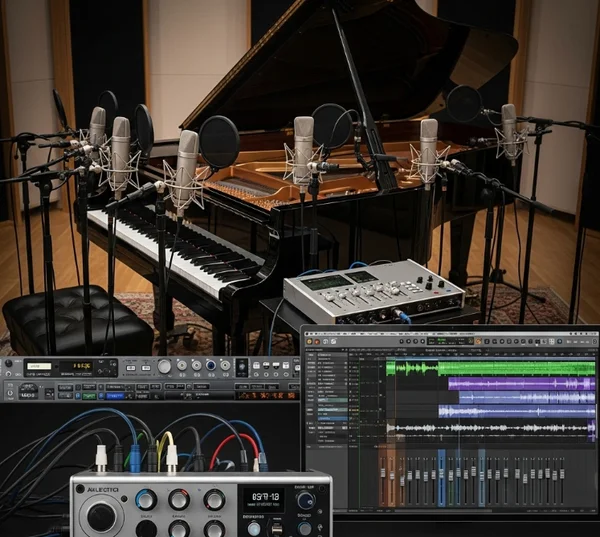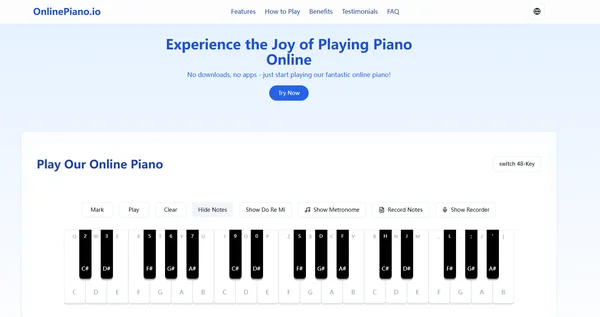Behind the Keys: How Online Pianos Work - Unveiling the Virtual Magic
Have you ever wondered how online pianos actually work? It seems like magic, doesn't it? You press a key on your keyboard, and authentic piano sounds emerge from your computer. This article delves into the technology that makes platforms like the online piano at onlinepiano.io tick, exploring the fascinating interplay of code, sound, and user interaction. We'll explore everything from audio processing to browser compatibility. If you're curious, you can visit an online piano to test the technology.
The Foundation: Web Audio API - Crafting Sound in the Browser
What is the Web Audio API and Why is It Important? The cornerstone of any modern online piano is the Web Audio API, a powerful JavaScript API that allows for audio processing and synthesis directly within a web browser. This API provides a flexible and efficient way to create, manipulate, and play audio, making it perfect for building interactive musical experiences.

The Web Audio API enables developers to:
- Load and decode audio samples (like individual piano notes).
- Create audio sources and destinations.
- Apply audio effects (like reverb and equalization).
- Control the volume, panning, and other audio parameters.
How Web Audio API is Used to Generate Piano Sounds: At the heart of a virtual piano lies a library of pre-recorded piano note samples. When a user presses a key, the corresponding sound sample is triggered using the Web Audio API. The API allows developers to precisely control the timing, volume, and other characteristics of the sound, creating a responsive playing experience. It can even layer multiple notes together to create chords and harmonies. JavaScript is the most common language used for this due to its robust functionality on various browsers.
MIDI Technology: The Language of Music in the Digital World
Understanding MIDI: Notes, Velocity, and Timing: MIDI (Musical Instrument Digital Interface) is a standardized protocol that allows electronic musical instruments and computers to communicate. In an online piano, MIDI data can represent the notes played, their velocity (how "hard" a key is pressed), and the timing of the performance.

MIDI data consists of messages that specify:
- Note On: A note has been pressed.
- Note Off: A note has been released.
- Velocity: The force with which the note was pressed.
- Control Change: Changes in volume, panning, or other parameters.
How an Online Piano Interprets MIDI Data: When you interact with an online keyboard, those actions can be translated into MIDI data. This data is then processed by the code to trigger the appropriate piano sounds. The velocity information is used to control the volume of the notes, creating a dynamic performance. In short, MIDI data can serve as the translator allowing a user's fingers to communicate with the sound system.
Creating Realistic Piano Sounds: From Samples to Synthesis
Sampling and Sound Design: Building a Virtual Piano Tone: Creating a realistic virtual piano sound requires careful sampling and sound design. Developers often start by meticulously recording each note of a real piano at multiple velocity levels. This captures the subtle nuances of the instrument for a dynamic and expressive sound.

These samples are then processed and optimized for web use. Audio editing software is used to clean up the samples, remove noise, and adjust volume levels, forming the foundation for the sound engine.
Audio Effects and Processing: Adding Depth and Realism: To further enhance the realism of an online piano sound, developers use a variety of audio effects and processing techniques. These include:
- Reverb: To simulate the natural reverberation of a room.
- Equalization: To shape the tonal balance of the piano sound.
- Chorus: To add richness and depth.
- Compression: To control the dynamic range for a more consistent sound.
These effects add depth, warmth, and realism to the online piano sound, making it more engaging and enjoyable to play.
Input Methods: From Keyboard to Touchscreen - Flexibility for Users
Keyboard Input: Mapping Keys to Piano Notes: A key feature of most online pianos is the ability to be played using a computer keyboard. Developers carefully map each computer key to a specific piano note to allow users to play melodies and chords with familiar controls. This mapping is often designed to be intuitive and may include visual guides or customization options.
Touchscreen Support: Creating a Responsive Mobile Experience: In addition to keyboard input, many online pianos also support touchscreen devices. This allows users to play on a smartphone or tablet. A well-designed touchscreen interface should be responsive and accurate, often incorporating multi-touch support to play chords.
Browser Compatibility: Ensuring a Consistent Experience Across Platforms

Cross-Browser Testing for Compatibility: Ensuring an online piano works seamlessly across different web browsers is a crucial aspect of development. Each browser (Chrome, Firefox, Safari, etc.) can have a slightly different implementation of web standards, potentially leading to inconsistencies. Developers must conduct extensive cross-browser testing on various devices to identify and fix compatibility issues.
Optimizing Performance for Different Browsers: Beyond simple compatibility, code is often optimized for performance on different browsers. This can involve using browser-specific techniques and workarounds to improve the speed and responsiveness of the virtual piano.
The Code: The Structure of a Virtual Instrument
The General Structure of an Online Piano Codebase: A well-built online piano codebase is typically structured in a modular way for easier maintenance and extension. Key modules might include:
- Audio Engine: Handles loading, processing, and playback of audio samples.
- Input Controller: Interprets user inputs (keyboard, touch, MIDI) and translates them into commands.
- User Interface (UI): Renders the visual keyboard and handles user interactions.
- Effects Processor: Applies audio effects to the piano sound.
Key Algorithms for Sound Generation: At the heart of an online piano lie key algorithms that handle note generation and sound processing. These algorithms are responsible for calculating note frequencies, loading and playing the correct audio samples, applying effects, and controlling volume and panning, all while being optimized for smooth performance.
Challenges and Solutions in Online Piano Development
Minimizing Latency for Real-Time Performance: One of the biggest challenges in building an online piano is minimizing latency—the delay between pressing a key and hearing the sound. High latency makes it difficult to play accurately. Developers use various techniques to address this, such as low-latency audio processing and highly optimized code.
Handling Audio Glitches and Performance Issues: Audio glitches can be caused by many factors, including browser bugs, network congestion, or hardware limitations. Robust error handling and providing users with troubleshooting tips are common strategies to mitigate these issues.
Harmonizing Technology and Music: The Future of Online Pianos
The modern online piano is a sophisticated piece of technology that brings the joy of music to anyone with a browser. By combining the power of the Web Audio API, MIDI technology, and careful sound design, developers have created virtual instruments that are both realistic and accessible.
We encourage you to try an online piano and experience the magic for yourself. Visit onlinepiano.io today! and see what you can create. Your exploration helps drive the continued refinement and expansion of these amazing virtual pianos.
Your Burning Questions About Online Piano Technology
What programming languages are used to build online pianos?
The primary language is JavaScript, leveraging HTML and CSS for the user interface.
How do online pianos handle different screen sizes?
They use responsive web design principles to ensure the interface adapts seamlessly to different screen sizes and devices.
Is the code for most online pianos open source?
Generally, the code for commercial or polished online piano websites is proprietary and not open source, though some developers may share certain libraries or techniques.
What are the system requirements for running an online piano?
Most modern online pianos are designed to run on up-to-date web browsers and devices. A stable internet connection is always recommended for the best experience.
Can I contribute to the development of online pianos?
While most specific platforms may not have a formal public contribution program, engaging with the web development and music technology communities is a great way to learn and eventually contribute to open-source projects in this space.